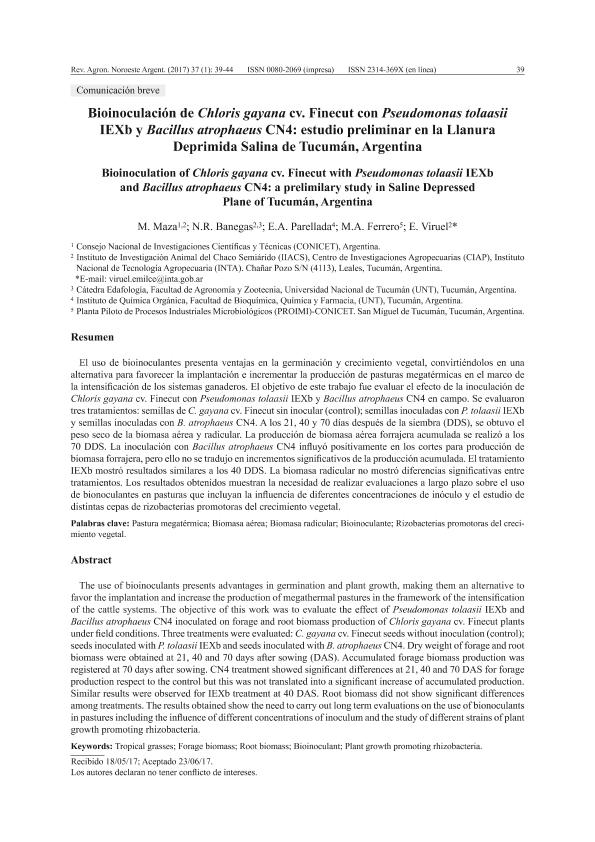Artículo
El uso de bioinoculantes presenta ventajas en la germinación y crecimiento vegetal, convirtiéndolos en una alternativa para favorecer la implantación e incrementar la producción de pasturas megatérmicas en el marco de la intensifiación de los sistemas ganaderos. El objetivo de este trabajo fue evaluar el efecto de la inoculación de Chloris gayana cv. Finecut con Pseudomonas tolaasii IEXb y Bacillus atrophaeus CN4 en campo. Se evaluarontres tratamientos: semillas de C. gayana cv. Finecut sin inocular (control); semillas inoculadas con P. tolaasii IEXb y semillas inoculadas con B. atrophaeus CN4. A los 21, 40 y 70 días después de la siembra (DDS), se obtuvo el peso seco de la biomasa aérea y radicular. La producción de biomasa aérea forrajera acumulada se realizó a los 70 DDS. La inoculación con Bacillus atrophaeus CN4 influyó positivamente en los cortes para producción de biomasa forrajera, pero ello no se tradujo en incrementos signifiativos de la producción acumulada. El tratamiento IEXb mostró resultados similares a los 40 DDS. La biomasa radicular no mostró diferencias signifiativas entre tratamientos. Los resultados obtenidos muestran la necesidad de realizar evaluaciones a largo plazo sobre el uso de bionoculantes en pasturas que incluyan la inflencia de diferentes concentraciones de inóculo y el estudio de distintas cepas de rizobacterias promotoras del crecimiento vegetal. The use of bioinoculants presents advantages in germination and plant growth, making them an alternative to favor the implantation and increase the production of megathermal pastures in the framework of the intensification of the cattle systems. The objective of this work was to evaluate the effect of Pseudomonas tolaasii IEXb and Bacillus atrophaeus CN4 inoculated on forage and root biomass production of Chloris gayana cv. Finecut plants under field conditions. Three treatments were evaluated: C. gayana cv. Finecut seeds without inoculation (control); seeds inoculated with P. tolaasii IEXb and seeds inoculated with B. atrophaeus CN4. Dry weight of forage and root biomass were obtained at 21, 40 and 70 days after sowing (DAS). Accumulated forage biomass production was registered at 70 days after sowing. CN4 treatment showed significant differences at 21, 40 and 70 DAS for forage production respect to the control but this was not translated into a significant increase of accumulated production. Similar results were observed for IEXb treatment at 40 DAS. Root biomass did not show significant differences among treatments. The results obtained show the need to carry out long term evaluations on the use of bionoculants in pastures including the influence of different concentrations of inoculum and the study of different strains of plant growth promoting rhizobacteria.
Bioinoculación de Chloris gayana cv. Finecut con Pseudomonas tolaasii IEXb y Bacillus atrophaeus CN4: estudio preliminar en la Llanura Deprimida Salina de Tucumán, Argentina
Título:
Bioinoculation of Chloris gayana cv. Finecut with Pseudomonas tolaasii IEXb and Bacillus atrophaeus CN4: a prelimilary study in Saline Depressed Plane of Tucumán, Argentina
Maza, Marianela ; Banegas, Natalia Romina
; Banegas, Natalia Romina ; Parellada, Eduardo Alberto
; Parellada, Eduardo Alberto ; Ferrero, Marcela Alejandra
; Ferrero, Marcela Alejandra ; Viruel, Emilce
; Viruel, Emilce
 ; Banegas, Natalia Romina
; Banegas, Natalia Romina ; Parellada, Eduardo Alberto
; Parellada, Eduardo Alberto ; Ferrero, Marcela Alejandra
; Ferrero, Marcela Alejandra ; Viruel, Emilce
; Viruel, Emilce
Fecha de publicación:
06/2017
Editorial:
Universidad Nacional de Tucumán. Facultad de Agronomía y Zootecnia
Revista:
Revista Agronómica del Noroeste Argentino
ISSN:
0080-2069
e-ISSN:
2314-369X
Idioma:
Español
Tipo de recurso:
Artículo publicado
Clasificación temática:
Resumen
Archivos asociados
Licencia
Identificadores
Colecciones
Articulos(CCT - CORDOBA)
Articulos de CTRO.CIENTIFICO TECNOL.CONICET - CORDOBA
Articulos de CTRO.CIENTIFICO TECNOL.CONICET - CORDOBA
Articulos(PROIMI)
Articulos de PLANTA PILOTO DE PROC.IND.MICROBIOLOGICOS (I)
Articulos de PLANTA PILOTO DE PROC.IND.MICROBIOLOGICOS (I)
Citación
Maza, Marianela; Banegas, Natalia Romina; Parellada, Eduardo Alberto; Ferrero, Marcela Alejandra; Viruel, Emilce; Bioinoculación de Chloris gayana cv. Finecut con Pseudomonas tolaasii IEXb y Bacillus atrophaeus CN4: estudio preliminar en la Llanura Deprimida Salina de Tucumán, Argentina; Universidad Nacional de Tucumán. Facultad de Agronomía y Zootecnia; Revista Agronómica del Noroeste Argentino; 37; 1; 6-2017; 39-44
Compartir



